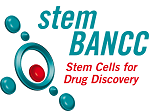The magic of iPSCs
IPSCs are created when a normal adult cell is reprogrammed to become ‘pluripotent’, meaning it is able to give rise to all the different kinds of cells that make up the human body. As such, human iPSCs can provide scientists with a variety of human cell types that can be used in research and drug development. Research tools based on human iPSCs offer the promise of more reliable results than research tools based on animal cells. When StemBANCC started, iPSC technology was still in its infancy and many scientists struggled to access high quality, well-characterised human iPSCs for use in research.
The goal of StemBANCC was to make a large number of iPSC lines available for the scientific community. The cells came from people with neurodysfunctional diseases (migraine, autism, schizophrenia, and bipolar disorder), central nervous system disorders (dementias), peripheral nervous system disorders (pain), and diabetes, as well as people who had experienced adverse reactions to drugs and healthy people. By the end of the five-year project, the team had generated 491 quality controlled, well-characterised iPSC lines from 496 people. In this way, StemBANCC addressed the challenge of finding more reliable ways to translate results from early laboratory tests to human patients. The iPSC lines are now accessible to the scientific community through EBiSC and Coriell.
Rigid ethical standards
Another important project outcome is the strict quality control and traceability of the iPSCs. Biological material (e.g. blood and skin samples), was collected from the recruited patients and healthy individuals with their informed consent and in line with rigid ethical standards. As an example of the practical traceability system, StemBANCC has met scientific, ethical and legal requirements to protect donor privacy while also maximising the availability of data. The system tracks samples throughout reprogramming and across the various physical locations where processing occurs within the StemBANCC consortium.
Other important project achievements include:
- new standardised protocols to generate different types of nerve cells from iPSCs; the protocols have been reproduced in multiple labs, proving their robustness;
- therapeutically relevant disease models in pain and Parkinson’s disease;
- new data on disease phenotypes including pain disorders, Alzheimer’s disease, Parkinson’s disease, autism, and diabetes;
- a study on the effect of drugs on a range of iPSC derived cell types, providing researchers with an important source for future work;
- the creation of the single-point access database (operated by StemDB) with all relevant iPSC information.
For the benefit of industry, academia, and SMEs
Thanks to StemBANCC, the scientific community now has high quality, disease-relevant human iPSCs already that are already being used to study disease biology, and to discover and develop new drugs.
Through StemBANC, there has been a significant transfer of knowledge from industry to academia and SMEs on how to use iPSCs to establish disease models for translational research. Furthermore, academia obtained a deeper understanding of the critical requirements of turning basic biomedical research into medicines, while undertaking the joint projects that are globally unique, which resulted with the utilisation of complementary expertise and knowledge in academia and industry. Academics also gained best practice on working with iPSC disease models to ensure reproducibility of the results.
For their part, the pharmaceutical companies involved in the project have used StemBANCC to establish their own stem cells expertise, and they are now using relevant in vitro models and assays in early stage drug discovery and safety evaluation.
SME Newcells Biotech is a spin-out company from the University of Newcastle, that is producing, reprograming and differentiating iPSC lines and creating innovative cross-species tests for specific studies. Another spin-off combines the analysis of electronic health records with stem cell studies in order to validate the data.
What’s next?
The accessibility of iPSC lines with the donors’ disease background and the development of the disease-relevant cell types could lead pharmaceutical companies to make further investments as a means of increasing the chances of translating drug candidates into efficacious treatments for the patients. The work of StemBANCC has significantly contributed to establishing methods and platforms to de-risk drug discovery. Ultimately, the use of human cellular models will enable improvements in the selection of compounds that are efficacious and reduce the risk of toxicity. Although these benefits will take some time to materialise, StemBANCC has laid the foundations. Additionally, the generation of relevant cells and assays can in the future potentially lead to a reduction in the use of animals in drug development, thus providing one more important legacy for StemBANCC.

